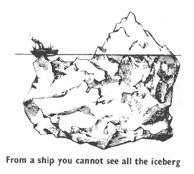Chapter: SCIENCE EXPERIMENTS & AMUSEMENTS FOR CHILDREN BY CHARLES VIVIAN. Simple Technical Steped Practical Projects for school and college students.
Miniature Iceberg

Miniature Iceberg
You will need: Bowl of water, plastic mug.

Many ships have been
wrecked by icebergs which drift southward from the Arctic regions. Icebergs are
huge, floating islands of ice which present a great threat to shipping.
Because of the relative
density of ice and water, some seven-eighths of an iceberg is beneath the
surface as it floats and only one-eighth can be seen above the surface. A ship
can be hundreds of feet away from the visible part of an iceberg and still run
against ice below the surface as shown above.
Test this for yourself by
filling a plastic cup with water and freezing it solid in the refrigerator.
Remove the cup and allow warm water to run over the outside for a few moments.
This will loosen the block of ice and enable you to remove it.
Fill a bowl with water and
float the ice in the bowl. You will quickly see how much of the ice is below
the surface when your miniature iceberg is floating.

Children learn best through doing
Before children can
understand a thing, they need experience: seeing, touching, hearing, tasting,
smelling; choosing, arranging, putting things together, taking things apart.
Experimenting with real things.
Old-time school teaching
used only words and the teachers thought children knew something if they could
repeat it. Now we know better. To reach practical understanding we do not need
to use many words with young children.
Children are
clever. They learn a lot, without being taught. The greatest skill - to be able
to talk, to communicate is learnt outside school. In the classroom it's the
children who need to talk the most. Unfortunately it is the teacher who does
most of the talking!
Related Topics